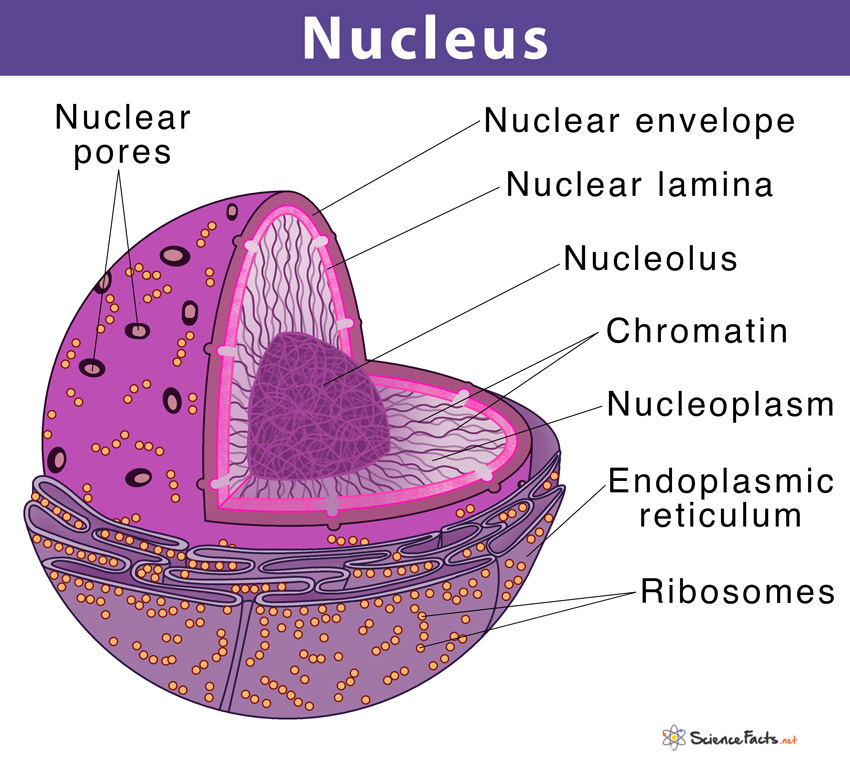Cell Nucleus: Definition, Structure, and Functions
What is a Nucleus
The nucleus is a double membrane-bound organelle located centrally only in a eukaryotic cell, enclosing the DNA, the genetic material. It is the most important and defining feature of all higher organisms, including plant and animal cells, whose main function is to control and coordinate the functioning of the entire cell.
The word ‘nucleus’ (plural: nuclei) is derived from the Latin word ‘nucleus‘, meaning ‘kernel’ or ‘seed’.
Structure and Characteristics
The largest and most prominent organelle in the cell, the nucleus, accounts for almost 10% of the volume of the entire cell. In mammalian cells, the average diameter of the nucleus is approximately 6 µm in size. Mostly the shape of the nucleus is found to be either spherical or oblong. Eukaryotes usually contain a single nucleus, however erythrocytes and platelets are without a nucleus and osteoclasts of bones have many of them. The color of the nucleus is usually grayish but can differ depending on the type of the cell.
Parts and Their Functions
Anatomically, the nucleus of all plant and animal cell is made up of several components that are listed below. All of these components work together in order for the nucleus to accomplish its purpose as the ‘controlling center’ of the cell.
1) Nuclear Envelope and Nuclear Pores
Surrounding the nucleus, the nuclear envelope is made of a phospholipid bilayer, similar to cell membranes, and contains tiny openings called nuclear pores over them. The two membranes are often referred to as the inner and outer nuclear membranes with a fluid-filled region called perinuclear space in between. The perinuclear space has a thickness of 20 to 40 nm. The outer membrane is attached to ribosomes and is continuous with the cell’s endoplasmic reticulum, a system that helps to package, transport, and export substances outside the cell.
Functions
- Nuclear envelope separates the nuclear content from the cytoplasm an is selectively permeable in nature
- Nuclear pores regulate the flow of molecules into and out of the nucleus
2) Nuclear Lamina
They are meshwork of protein filaments organized in a net-like fashion that line below the inner nuclear membrane. The proteins that make up the nuclear lamina are known as lamins, which are intermediate filament proteins.
Functions
- Supports the nuclear envelope, maintaining the overall shape and structure of the nucleus
3) Chromatin
It is a complex of genetic material (DNA or RNA) and proteins found in a resting or non-dividing cell nucleus. The chromatin is classified into two types, heterochromatin and euchromatin, based on functions. The heterochromatin is a functionally inactive form of chromatin, found near the nuclear envelope. On the contrary, euchromatin is a mild, less condensed form that is in functionally active state. An organized chromatin material that is highly condensed and paired is known as the chromosome.
Functions
- Contains hereditary information and instructions necessary for controlling processes such as metabolism, cell growth, and cell division
- Helps in gene expression where DNA molecules make an RNA copy, a process called transcription which is later converted to proteins by a process called translation
4) Nucleoplasm
Also known as karyoplasm, it is found inside the nucleus, and is a gelatinous substance similar to the cytoplasm, being composed mainly of water with dissolved salts, enzymes, and suspended organic molecules.
Functions
- Protects the nuclear content by providing a cushion around the nucleolus and the chromosome
- Supports the nucleus to hold its shape
- Provides a medium through which enzymes and fragments of genetic materials (DNA or RNA), can be transported throughout the nucleus
5) Nucleolus
It looks like a dark spot within the nucleus and is a dense, membrane-less structure composed of RNA and proteins along with granules and fibers that remain attached to chromatin. The nucleolus contains multipleregions called nucleolar organizers that are the segments of chromosomes that contain the genes for ribosomal RNA. The nucleolus disappears when a cell undergoes division and is reformed after the completion of cell division.
Functions
- Synthesize ribosomes that are involved in protein synthesis
FAQs
Ans. The nucleus was the first organelle to be discovered by Antonie van Leeuwenhoek during his study involving microorganisms, which was further described in detail by Robert Brown in 1831.
Ans. Prokaryotic cells, including bacteria and archaea, do not have a true nucleus; instead, they have a membrane-less nucleoid region that holds their free-floating DNA.
Ans. Both archaebacteria and eubacteria being prokaryotic organisms lack all membrane-bound organelles, including the nucleus.
Ans. Viruses do not have any cell organelles, including nucleus in their cell.
Ans. Like all eukaryotic cells, protists have a characteristic central compartment called the nucleus, which houses their genetic material.
Ans. Being eukaryotes, fungi, and amoeba has a membrane-bound nucleus within their cell.
Ans. White blood cells also known as leucocytes have a distinct nucleus that differentiates them from other blood cells.
Ans. The DNA, which is the genetic material of the cell, is a polymer of nucleotides, found within the nucleus.
Ans. Eukaryotic DNA never leaves the nucleus but is copied into RNA molecules, which may then travel out of the nucleus.
Ans. A nucleus is a membrane-bound organelle that houses DNA, the genetic material of eukaryotes whereas nucleoid is an irregularly shaped region that houses the genetic material of prokaryotes.
Ans. Nucleus is a membrane-bound organelle that houses DNA, the genetic material of a eukaryotic cell whereas nucleolus is a sub-organelle found within the nucleus containing RNA and is responsible for ribosome synthesis.
-
References
Article was last reviewed on Thursday, February 4, 2021




